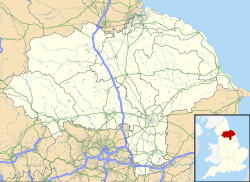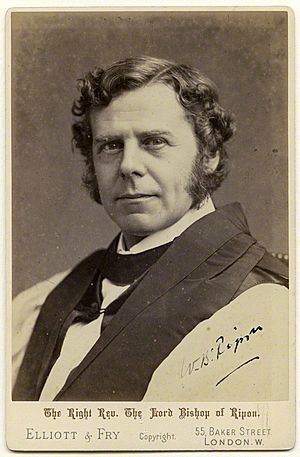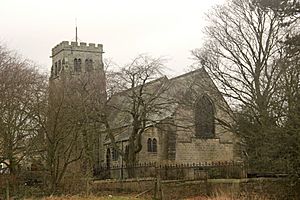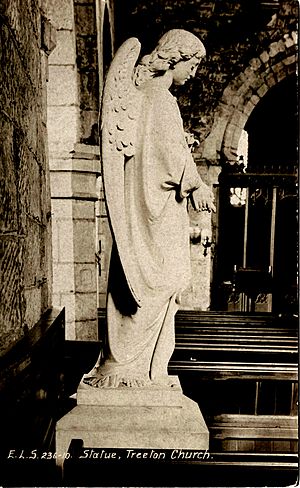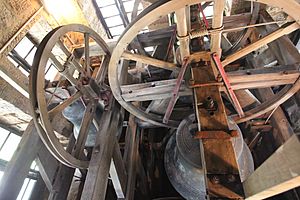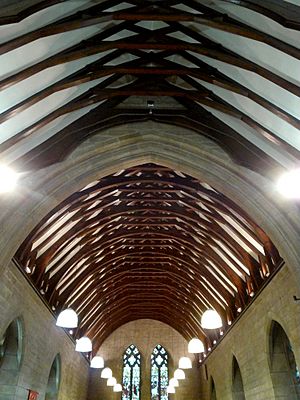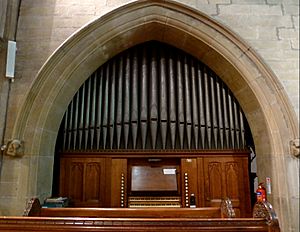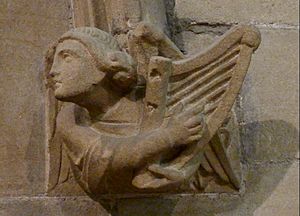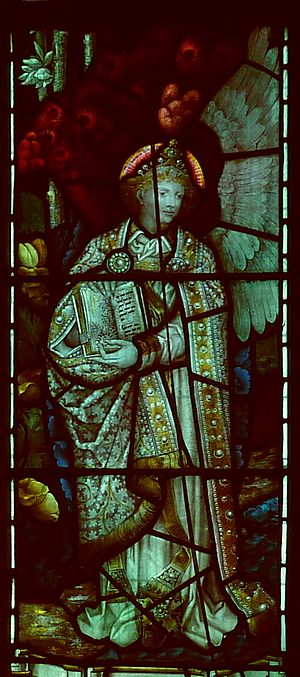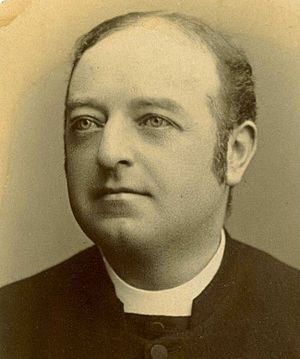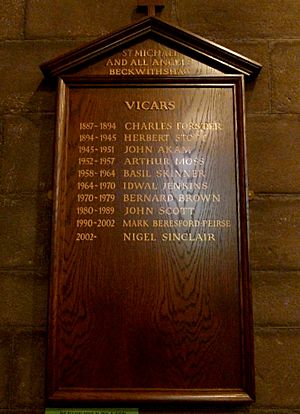Church of St Michael and All Angels, Beckwithshaw facts for kids
Quick facts for kids Church of St Michael and All Angels, Beckwithshaw |
|
|---|---|
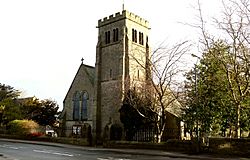
Beckwithshaw Church, 2014
|
|
| 53°58′25″N 1°35′36″W / 53.97361°N 1.59333°W | |
| OS grid reference | SE267625 |
| Location | Church Row, Beckwithshaw, North Yorkshire, HG3 1QW |
| Country | England |
| Denomination | Church of England |
| Churchmanship | Central |
| History | |
| Status | Parish church |
| Founded | 1886 |
| Dedication | St Michael and All Angels |
| Dedicated | 1886 |
| Consecrated | 1886 |
| Architecture | |
| Functional status | Active |
| Heritage designation | Grade II listed |
| Architect(s) | W. Swinden Barber, FRIBA Contractor: James Simpson |
| Architectural type | Church of England parish church |
| Style | Arts and Crafts movement Gothic Revival |
| Specifications | |
| Bells | 6 (D#, C#, B, A#, G#, F#) |
| Tenor bell weight | 13 long cwt 15 lb (1,471 lb or 667 kg) |
| Administration | |
| Parish | Ecclesiastical parish of St Robert of Knaresborough, Pannal (300230 30/230) |
| Deanery | Harrogate (30104) |
| Archdeaconry | Richmond (301) |
| Episcopal area | Ripon |
| Diocese | Leeds |
The Church of St Michael and All Angels, also known as Beckwithshaw Church, is an Anglican church in Beckwithshaw, North Yorkshire, England. It was built between 1886 and 1887 by William Swinden Barber. The church was designed in the Gothic Revival style, which brought back medieval church designs. It also shows influences from the Arts and Crafts movement, a style that focused on traditional craftsmanship.
The church's beautiful stained glass windows were added in 1892. This church is a Grade II listed historic building. It is special because it has kept almost all its original furniture and decorations, except for one missing statue. In 2018, plans were approved to make some changes, including removing the original wooden pews. The first vicar of this church was Charles Farrar Forster, who served from 1887 to 1894.
Contents
Where is Beckwithshaw Church?
When the church was built in the late 1800s, Beckwithshaw was a small hamlet (a tiny village). It was about two and a half miles from Harrogate. The church's area was created from the nearby Pannal parish. Today, Beckwithshaw is a small village.
Who Paid for the Church?
Generous Donors
Dr. Henry Williams and his wife lived at Moor Park House in Beckwithshaw. They bought the house in 1882. Their home and estate provided jobs for many local people for a long time. The Williams family paid for the entire church themselves, costing £8,000. They also set aside £5,000 to help pay for the church's future needs.
Mrs. Williams did not want a graveyard at the church. This might have been because people in the area at that time were sometimes afraid of things related to death.
The Architect and Builder
The church's architect was William Swinden Barber from Halifax. He was a member of the Royal Institute of British Architects (FRIBA). Barber designed many other buildings, mostly Anglican churches, in the Neo-Gothic and Arts and Crafts styles. He also designed all the inside decorations and furniture for his buildings.
The main builder for the church was James Simpson from Harrogate. He was a stonemason and an important local figure.
Church History
Before this church was built, people in Beckwithshaw had to go to the Church of All Saints, Harlow Hill or a local school room for church services. The first stone for the new church was laid on September 29, 1884. This day was special because it was the feast day of St Michael and also Mrs. Williams' birthday.
Consecration in 1886
The church was finished in 1886. It was officially opened and blessed by Mrs. Williams' uncle, The Bishop of Ripon, on September 29, 1886. Even though Beckwithshaw was just a small hamlet then, the church was full for the ceremony. There was a grand procession with the choir, church leaders, and many clergymen. The Bishop of Ripon gave a sermon. A collection was taken to help a church fund.
Golden Jubilee in 1936
The church celebrated its 50th anniversary (Golden Jubilee) on September 30, 1936. A special service was held by Rev. H.R. Stott, who had been the vicar for 42 years. The Bishop of Ripon also gave a sermon. By this time, Mr. and Mrs. Henry Williams had passed away. However, their family had continued to give generous gifts to the church and the village. In the same year, the church building and the organ were repaired.
The Church Building
The church is built from local sandstone. It was described as a "strong building, well-furnished inside, and perfect as a parish church." The people who paid for it wanted a simple, strong building, not an overly fancy one. The church still looks almost exactly as it did when it was built in 1886. The only thing missing is a statue of St Michael defeating the Dragon, which used to be between the west windows.
The Tower and Bells
The church tower is on the south-west side of the building. It has an outside staircase leading to the bell ringers' room and the belfry (where the bells are). The main entrance to the church is through the ground floor of the tower.
The Bells
There are six bells in the tower. They are described as having a "nice" or "rich" sound. They were made at the Whitechapel Bell Foundry in 1886. The bells have the names of the company, Mears and Stainbank, and the names of the Williams family and their children cast into them. The largest bell, called Henry, weighs about 13.75 long tons. The bells are arranged in two levels inside the tower.
A group of bell ringers practices at the church on Monday evenings.
The inside of the church is made of local stone. It was designed to hold 120 to 150 people. The pulpit (where sermons are given) and the font (for baptisms) were carved from Caen stone in 1886 by William Pashley. The missing statue of St Michael and the Dragon was once in the nave.
The Chancel
The chancel is the area near the altar. It has a beautiful stone reredos (a screen behind the altar) also by William Pashley. It shows carved scenes of Bearing the Cross, the Crucifixion, and The Resurrection. The choir stalls and nave seats are made of oak wood. The altar rail and other metal parts are made of brass. The floors in the aisles and chancel are covered with patterned tiles.
The Organ
Just over a year after the church opened, a new organ was installed in December 1887. It was another gift from Mrs. Williams. The organ was built by Father Willis of Messrs Willis and Sons in London. It was part of the church's original design, built into a special room on the north side of the chancel. The organ has a beautiful oak case and metal pipes.
The Bishop of Ripon returned for the organ's opening day. As of 2014, the organist was Nigel Duce, who also plays at Halifax Minster.
Windows and Carvings
The window designs and carvings on the reredos, pulpit, and font were made in 1889. They were designed to look like art from the mid-1300s, fitting the Gothic Revival style.
The large east window, installed in 1886, shows St Michael and all Angels, the Nativity (Jesus' birth), and the Adoration of the Magi (the wise men visiting Jesus). These stained glass images were designed by Charles Eamer Kempe. The west window, also from 1886, shows the archangels Gabriel, Uriel, Michael, and Raphael.
On June 26, 1892, five more stained glass windows by Kempe were dedicated. These windows were given by Henry Williams and others. The images in these windows tell stories from the Book of Revelation, which describes St John's visions on the Isle of Patmos. For example, one window shows St John seeing the holy city of Jerusalem, and another shows an angel with a key to the Bottomless Pit.
Vicars of Beckwithshaw
A memorial board inside the church lists all the past clergy (vicars).
First Vicar
The first vicar was Rev. Charles Farrar Forster (1848–1894), who served from 1887 to 1894. He was known as a very hardworking and interesting preacher. He cared deeply about the church and the local school. He was also a member of the Royal Geographical Society. His funeral was well-attended by many people who respected him. He is buried at Harlow Hill Cemetery.
Later Vicars
Rev. Herbert R. Stott followed Rev. Forster, serving for a very long time, from 1894 to 1945. His son, Philip Harle Stott, was a promising student but sadly died in World War I in 1918. He is remembered on war memorials.
After Rev. Stott, other vicars included Rev. John Akam (1945–1951), Rev. Arthur Moss (1952–1958), Rev. Basil Skinner (1958–1964), Rev. Idwal Jenkins (1964–1970), and Rev. Bernard Brown (1970–1979).
Since 1980, the churches of Pannal and Beckwithshaw have shared a vicar. John T. Scott was the first vicar to serve both parishes from 1980 to 1989. This arrangement has continued. Rev. Mark Beresford-Peirse was vicar from 1990 to 2002, followed by Nigel Sinclair from 2002 to 2013. Rev. John Smith became the vicar for both churches on January 20, 2014.
Events and Services
The church holds four regular Sunday services each month. Three are morning services, and one is an evensong (evening service). There is also a junior church for children during the morning services when school is in session. A special "pram service" for families with young children is held on the fourth Thursday of each month.
Changes to the Church
In May 2018, the church received permission to update its building. This plan includes adding a modern annex on the north side with a kitchen and toilet. The plans also involve removing all the original pews, which were designed by the architect William Swinden Barber. The future of these pews is not known.
See also
 In Spanish: Iglesia de San Miguel y Todos los Ángeles (Beckwithshaw) para niños
In Spanish: Iglesia de San Miguel y Todos los Ángeles (Beckwithshaw) para niños
- Listed buildings in Beckwithshaw


